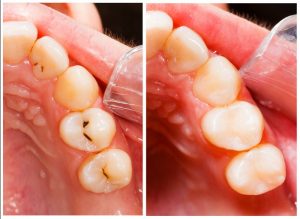
It’s been a while since you’ve seen the dentist, but you’re back for your checkup now. They examine your teeth and discover that a cavity has developed. Untreated, tooth decay can spread to encompass the entire tooth, jump to other teeth and the supporting jaw bone, and even cause permanent damage or death. Getting your cavity filled prevents all that and saves your natural tooth. But what is a filling exactly? What is it made of? Why is it important to know what materials your dentist is using for your fillings? Get the answers to all your questions about fillings here in this post!
What is a filling?
When you have tooth decay, harmful bacteria and acids degrade your tooth enamel. The diseased portions of your tooth need to be removed to prevent further infection, leaving a hole in your tooth. A filling, as the name suggests, fills in this hole, compensating for the structure that has been lost to decay. That way, you can continue using this tooth for daily functions, including eating and speaking. The filling also serves as a barrier to keep bacteria from re-infecting the tooth in the future.
What materials are fillings made of?
In the past, many types of materials have been used as tooth fillings, but the most common one for a long time was amalgam, a compound of mercury, silver, tin, and copper. With a dark silver hue, these fillings tend to stand out and are easily spotted by others. Nowadays, the most commonly used material is composite resin, a combination of dental plastic and fine ceramic particles. This flexible, biocompatible material can be shaded to match your tooth’s enamel. As a result, others may not be able to tell you ever had a cavity.
Why are metal fillings bad?
In addition to the obvious, unattractive silvery blobs left on your teeth, amalgam has other disadvantages as a filling material, including the following:
- It doesn’t bond well with your tooth’s natural structure, so your dentist has to remove extra structure to ensure that the filling stays in place.
- Some people worry about the potential negative health effects of amalgam fillings, particularly from the mercury content.
- Because metal conducts temperature, some patients have experienced sensitivity to hot and cold foods and drinks.
What are the advantages of tooth-colored fillings?
On the other hand, tooth-colored composite resin fillings address all the downsides of amalgam fillings: preserving your healthy tooth structure, safely strengthening your tooth, and protecting the vulnerable inner layers of your tooth from the heat and cold. Plus, you get to enjoy a more aesthetic look for your restored tooth!
Don’t be stuck in the past with outdated dental techniques and materials. If you need to have a cavity filled, make sure your dentist uses tooth-colored fillings so that you can take advantage of all the benefits they offer. Keeping your smile happy and healthy for the long term is important, and composite resin fillings help you do just that. If you have more questions about fillings or restorations, contact your dentist.
About the Author
Dr. Darren Koch has nearly two decades of experience as a dentist. After his general dentistry residency, he earned his Advanced Education in General Dentistry certificate. He continues to hone his skills through advanced training courses with Spear Education. In his practice, he offers tooth-colored fillings to restore patient’s teeth after tooth decay. To schedule an appointment with him, you can call (919) 859-6633 or click here.






